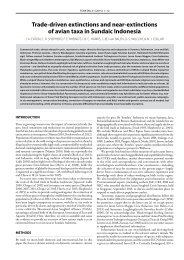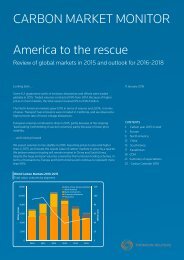Emissions Trading Worldwide
1TbjEHd
1TbjEHd
Create successful ePaper yourself
Turn your PDF publications into a flip-book with our unique Google optimized e-Paper software.
Taiwan<br />
under consideration<br />
On 1 July 2015, Taiwan enacted the Greenhouse Gas Reduction<br />
and Management Act, which sets a 50% emissions reduction target<br />
for 2050 compared to 2005 GHG levels. The Act charges the<br />
Taiwanese Environmental Protection Administration (TEPA) with<br />
the development of appropriate climate change policies to reach<br />
this target.<br />
An ETS is mentioned as a key option in the law, although no<br />
precise timeline is given for its implementation. The Act also outlines<br />
options for ETS design elements including: allocation, provisions<br />
for offsets and which considerations must be taken into<br />
account when setting the cap.<br />
Currently, preparations are focussing on mandatory reporting<br />
for entities from certain sectors with annual emissions above<br />
25,000 tCO 2 e. Reporting has been ongoing since 2013. Taiwan is<br />
also encouraging voluntary emission reduction efforts.<br />
background information<br />
Overall Ghg <strong>Emissions</strong> (excl. LULUCF) 270.68 MtCO 2 e (2012)<br />
OVERALL GHG EMISSIONS BY SECTOR<br />
MtCO 2 e<br />
7.5 % 1.4 % 0.7%<br />
Industrial processes (20.38)<br />
Agriculture (3.76)<br />
77.7 % 12.6 %<br />
Waste (1.96)<br />
energy (excl. transport) (210.41)<br />
transport (34.17)<br />
GHG Reduction Targets by 2050: 50% below 2005 GHG levels.<br />
other information<br />
mrv Reporting Frequency: Annual reporting of GHGs (CO 2, CH 4, N 2 O, SF 6,<br />
NF 3, PFCs and HFCs) for entities from certain sectors with annual emissions<br />
greater than 25,000 tCO 2e. Verification: Third-party verification is required.<br />
Framework: As of 2004, Taiwan introduced voluntary GHG reporting under<br />
the Air Pollution Control Act. This became mandatory in 2013 and is continued<br />
under the Greenhouse Gas Reduction and Management Act.<br />
Institutions involved TEPA<br />
Thailand<br />
under consideration<br />
The 11 th National Economic and Development Plan (2012–2016) of<br />
Thailand calls for several measures related to the development of<br />
a domestic carbon market. The National Climate Change Master<br />
Plan (2015–2050) also refers to carbon markets as a potential<br />
mechanism to reduce GHG emissions in the private sector. The<br />
importance of carbon markets has also been emphasized in<br />
Thailand’s INDC. In view of this, various programs have been initiated<br />
and/or are currently under development.<br />
In 2013, the Thailand Greenhouse Gas Management Organization<br />
(Public Organization) (TGO) has developed an MRV system<br />
for the Thailand Voluntary <strong>Emissions</strong> <strong>Trading</strong> Scheme (Thailand<br />
V-ETS). Furthermore, the Thailand Voluntary Emission Reduction<br />
Program (T-VER), which was launched in October 2014, has 20<br />
registered projects as of 2016, amongst which seven projects produced<br />
339,537 credits that can be used as offsets by companies<br />
and individuals.<br />
The TGO is also developing a Low Carbon City (LCC) Program<br />
as part of the World Bank’s PMR to help Thai provinces, cities, and<br />
municipalities to build a GHG inventory along with an MRV system<br />
for citywide emissions and set reduction targets. The TGO will<br />
translate these mitigation actions into emissions reduction certificates<br />
(“Certificates”) under the T-VER.<br />
background information<br />
Overall Ghg <strong>Emissions</strong> (excl. AFOLU) 350.7 MtCO 2 e (2012)<br />
OVERALL GHG EMISSIONS BY SECTOR MtCO 2 e (2012)<br />
9.6 %<br />
15.9 % 1.4 %<br />
73.1 %<br />
Industrial processes (33.5)<br />
Agriculture & land use change (55.7)<br />
Waste (5.0)<br />
energy (256.4)<br />
GHG Reduction Targets Thailand has no mandatory GHG reduction targets<br />
under the Kyoto Protocol. By 2020: In its Nationally Appropriate Mitigation<br />
Action (2014), Thailand committed to a voluntary 7–20% reduction compared<br />
to BAU in the energy and transport sectors. BY 2030: 20% reduction compared<br />
to BAU with a 25% reduction contingent on adequate and enhanced access<br />
to technology development and transfer, financial resources and capacity<br />
building support through a balanced and ambitious global agreement under<br />
the UNFCCC (INDC Submission).<br />
66




